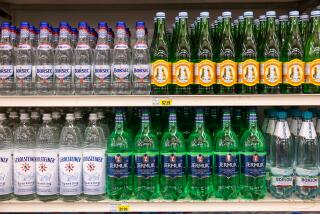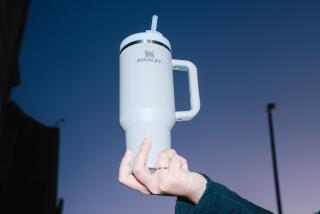What’s in a name? In branding, everything
- Share via
Your throat parched, you dash into a convenience store for a simple bottle of water. You stare at row after row, bin after bin of refreshing options. For a moment you hesitate. Aquafina or Evian? Dasani or Poland Spring? Splurge on an upscale sip of Vittel or Fiji or go for the cut-rate, store-brand guzzler?
What makes one bottle more special than the other; one taste better?
“Pixie dust,” said James Twitchell, a professor of English at the University of Florida who specializes in pop culture. “That’s pixie dust you’re tasting.”
Twitchell isn’t talking about genuine Tinkerbell glitter. It’s his cynical way of suggesting there is no difference in the product in the bottles. It is, simply, water.
But there is a powerful factor at work in how we perceive these thirst-slaking options. And that is called branding.
It’s also one of the strongest, most pervasive forces in our everyday lives.
Take a look in your cupboards or fridge, in your living room and medicine cabinet, in your driveway, on the desk at your office: Everything you bought, everything you eat, even the newspaper in your hands has been touched by branding. Branding -- how a consumer object has differentiated itself from its identical competitor -- is the reason you might drink Pepsi over Coke, lather up with Dial instead of Ivory, drive a Honda, not a Toyota. The choices you made from the myriad options of nearly identical products is the product of successful branding.
“Successful branding is selling,” said Lynn Altman, a partner in Brandmaker Express, a Manhattan branding firm. “You can’t have a product without the appeal designed into it. Branding is important because nine times out of 10 the marketplace is so overcrowded by pretty much the same product. You need the brand to pick one product instead of another.”
Branding is creating an identity, said Cynthia R. Cohen, founder of Strategic Mindshare, a retail strategy consulting firm. “Why is branding important? Because it works. There are so many choices for things. A brand helps communicate to people what it stands for.”
A brand is a connection, an instant identifier. The better the connection, the more powerful the brand. Or, as Twitchell would say: the better the story, the better the brand.
In an upcoming book “Branded Nation: Selling Culture in America” (due next year from Simon & Schuster), Twitchell, a prolific pop culture chronicler, has reduced the practice of branding to a simple, neat concept: storytelling. “What branding really is is a story attached to a product,” he said. “When you have a product that’s just like another product, there are any number of ways to compete. The stupid way is to lower your price. The smart way is to change the value of the product by telling a story about it.”
A modern example is bottled water. “We put it into a container. We say it’s from a glacier. Or from a really deep well. Or that the French like it,” he said. “If we get the story right we can charge a buck fifty for a substance that is essentially free and comes out of your tap.”
*
Greg Morago is writer for the Hartford Courant, a Tribune company.
More to Read
Inside the business of entertainment
The Wide Shot brings you news, analysis and insights on everything from streaming wars to production — and what it all means for the future.
You may occasionally receive promotional content from the Los Angeles Times.










